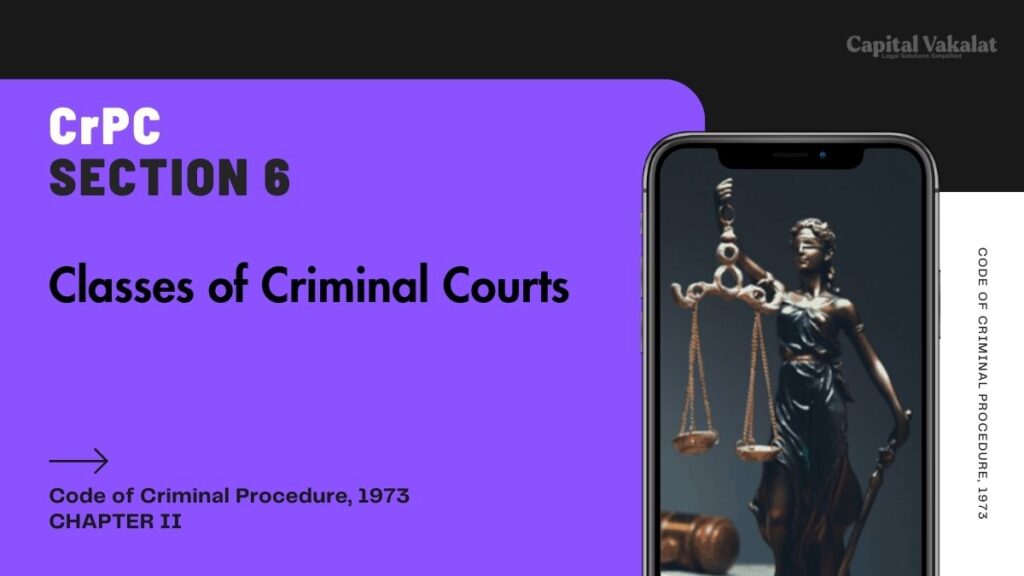The Indian justice system, particularly the criminal justice system, is a complex yet well-structured framework. The Code of Criminal Procedure (CrPC), 1973, acts as the bedrock for this system, outlining the procedures followed in criminal cases. Section 6 of the CrPC plays a crucial role by establishing the hierarchy of criminal courts in India.

This article delves into the intricacies of Section 6 CRPC, explaining the various classes of criminal courts and their jurisdictions.
Key Takeaways:
- Section 6 CRPC establishes four classes of criminal courts in each state.
- Each court class handles criminal cases of varying severity.
- Understanding the court hierarchy is essential for navigating the criminal justice system.
The Significance of Section 6 CRPC
Section 6 CRPC lays the foundation for a streamlined criminal justice system in India. By outlining the different classes of criminal courts, it ensures that cases are heard by courts with the appropriate jurisdiction and judicial authority. This classification helps maintain order, efficiency, and fairness within the system.
Classes of Criminal Courts under Section 6 CRPC
Here’s a breakdown of the four main classes of criminal courts established under Section 6 CRPC:
- Court of Session:
- Occupying the highest position in the hierarchy of trial courts, the Court of Session presides over serious offences, including those punishable with death, life imprisonment, or imprisonment exceeding ten years.
- Presided over by a Sessions Judge, who is an experienced and qualified judge.
- Can conduct trials based on charges framed by a magistrate and pronounce judgments.
- Also has appellate jurisdiction over cases decided by magistrates.
- Judicial Magistrate:
- This category comprises three sub-classes:
- Judicial Magistrate First Class (JMFC): Handles criminal cases punishable with imprisonment up to seven years. Examples include theft, assault, and criminal breach of trust.
- Metropolitan Magistrate (in Metropolitan areas only): Possesses the same jurisdiction as JMFC.
- Judicial Magistrate Second Class (JMII): Tries less serious offences punishable with imprisonment up to three years. Examples include public nuisance and criminal trespass.
- This category comprises three sub-classes:
- Executive Magistrate:
- Primarily focuses on preventive measures and maintaining law and order.
- Empowered to conduct inquiries, order arrests, and initiate preventive detention.
- Cannot try criminal cases or pronounce judgments.
Jurisdiction and Powers of Each Court Class
The following table summarizes the jurisdiction and powers of each court class under Section 6 CRPC:
| Court Class | Jurisdiction (Maximum Punishment) | Powers |
|---|---|---|
| Court of Session | Death, Life Imprisonment, >10 years Imprisonment | Try offences, pronounce judgments, hear appeals from magistrates |
| Judicial Magistrate (First Class) | Up to 7 years Imprisonment | Try offences, pronounce judgments |
| Judicial Magistrate (Second Class) | Up to 3 years Imprisonment | Try offences, pronounce judgments |
| Metropolitan Magistrate (in Metropolitan areas only) | Up to 7 years Imprisonment | Try offences, pronounce judgments |
| Executive Magistrate | – | Preventive measures, inquiries, arrests, preventive detention |
Factors Determining Which Court Hears a Case
The nature of the offence and the prescribed punishment determine which court will hear a criminal case. Here’s a general guideline:
- Serious Offences: Cases involving severe punishments (death, life imprisonment, or exceeding ten years) go to the Court of Session.
- Intermediate Offences: Offences punishable with imprisonment up to seven years are typically handled by the JMFC or Metropolitan Magistrate.
- Lesser Offences: Cases involving imprisonment up to three years are usually tried by the JMII.
Importance of Understanding Court Hierarchy
Understanding the court hierarchy established by Section 6 CRPC is crucial for several reasons:
- Filing Cases: Knowing the appropriate court to file a criminal complaint ensures a smooth and efficient legal process.
- Seeking Appeals: If dissatisfied with a lower court’s verdict, parties can appeal to the higher court with relevant jurisdiction.
- Understanding Legal Representation: Lawyers specializing in specific court levels can be chosen based on the court where the case is being heard.
Conclusion
Section 6 CRPC forms the backbone of the criminal court structure in India. By establishing a well-defined hierarchy, it ensures efficient handling of criminal cases at various levels. Understanding this classification empowers individuals to navigate the legal system effectively and seek justice.
Additional Considerations
- This article provides a general overview, and specific procedures may vary depending on the state and the nature of the offence.
- It’s always advisable to consult with a qualified lawyer for legal advice on
Frequently Asked Questions
Which court handles the most serious offences?
The Court of Session, presided over by a Sessions Judge, tries offences punishable with death, life imprisonment, or imprisonment exceeding ten years.
Can a Magistrate pronounce judgments in all cases?
No. Judicial Magistrates (First Class and Second Class) can pronounce judgments in cases within their jurisdiction (up to 7 years or 3 years imprisonment respectively). Executive Magistrates cannot pronounce judgments and focus on preventive measures.
Where do I file a complaint for a crime like theft?
Theft cases usually fall under the jurisdiction of the Judicial Magistrate First Class (JMFC) or Metropolitan Magistrate (in metro areas). They can handle offences punishable up to seven years.
If I disagree with a magistrate’s decision, what can I do?
You can appeal the decision to the Court of Session, which has appellate jurisdiction over magistrates’ courts. This process requires legal guidance, so consulting a lawyer is recommended.